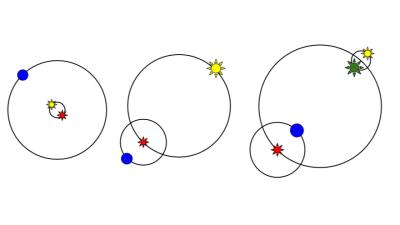
Stars, Star Wars, and Science
The image of multiple stars, moons, or large planets in the sky is a quick visual way to show the audience that a film or television series isn’t set on Earth. It’s effective, too; it doesn’t require any dialogue or time spent explaining the mechanics of the solar system, but only a few expository shots or background images. And everyone—children and adults—knows that Earth has a single moon and a single bright star in the sky and can interpret the intent.
Consider an iconic scene early in Star Wars: A New Hope. Luke Skywalker slowly walks from his family’s modest farmstead. He stops and gazes upon a sunset of not one, but two suns. The message of the scene is clear: Luke is a farm boy from a small backwater town who is ready for something bigger, something more than this. But even though Luke is the everyman, he’s not an everyman of Earth. He is from a place familiar yet distinctively other. The two stars of Tatooine make that fact unmistakable.
When Kepler-16b—a planet like Tatooine orbiting two stars—was discovered in 2011, the press immediately called the planet a “Real-Life ‘Tatooine.’” 1 These comparisons repeat each time another planet in a binary star system is discovered. 2 When the discovery was announced, the press briefing included a representative from Industrial Light and Magic alongside the panel of scientists. 3 NASA later commissioned a poster for Kepler-16b referencing Tatooine. 4 These comparisons were intentionally fostered by staff scientists at NASA. Why would NASA want to draw a link between Star Wars and the real science of discovering exoplanets (planets in other solar systems)?
It’s simple: NASA wanted to draw on the popularity of Star Wars to get people excited about astronomy. But links between science fiction and science are as old as the genre itself. Many science fiction authors like Isaac Asimov, Carl Sagan, and Arthur C. Clarke are also professional scientists. Other authors, starting as far back as Mary Shelley with her work on Frankenstein in 1818, 5 have extensively studied and made efforts to explain current scientific theory in their works. In turn, engineers and scientists have cited inspiration from science fiction in breakthrough technologies ranging from cell phones (in Star Trek) 6 to self-driving cars (e.g. Knight Rider). 7
Science fiction is relevant not only to the practice of science but also in learning science. Research has shown that science fiction media can be used in the classroom to teach multiple subjects, including biology, 8 physics, 9 and astronomy. 10 Using it effectively can be difficult, because writers and artists are generally laypersons and not experts in the science that they are portraying. It would thus be unreasonable to demand scientific rigor from science fiction media. Additionally, the demands of drama can frequently come into tension with scientific accuracy.
Criticizing the scientific accuracy of fiction is nothing novel; a simple Google search for “errors in science fiction films” yields hundreds of millions of results. 11 They commonly take the form of lists of either common errors or all of the errors in a single film, with titles like “Top 5 ‘Science Done Wrong’ Moments in Movies” 12 or “The 15 Most Inaccurate Science Fiction Films of All Time.” 13 While this approach is popular, it tends to amount to little more than pedantry. A more productive question would be why do we see these misconceptions in science fiction? Why are fictional universes different from ours, are they different in consistent ways, and what do these differences tell us?
I will argue that there are in fact broad and consistent patterns in the portrayal of solar systems in science fiction. There are two separate models in use, even sometimes within the same text, one that is scientifically correct and one that is at odds with how scientists understand the universe. Which one is shown depends on whether the authors and artists are considering the solar system from an external view or when looking up at the sky.
Comparative Work Overview
In this work I will be comparing what is known to be true of our solar system and other real solar systems to what is observed in a selection of five recent science fiction and fantasy media. In particular, in these works, the configuration of the solar system is some combination of (1) clearly laid out for the viewers, (2) explicitly discussed by the characters or creators, or (3) figures prominently in establishing shots. A brief overview of each work follows.
In the sci-fi horror film Pitch Black (2000), a transport ship carrying a dozen people crash lands on an unnamed desert planet. On the planet’s surface, the passengers discover that it is always daytime because the system has not one but three stars, at least one of which is always visible above the horizon. An orrery located in an abandoned geology station models this unusual solar system for the survivors, and also allows them to predict that an extended eclipse is coming. They also find that the interior of the planet is filled with swarms of light-sensitive monsters, which will be able to come to the surface during the eclipse. Predictably, most of the cast is murdered while they try to escape.
The 100 (The CW, 2014-present) takes place hundreds of years in Earth’s future, after humanity has mostly died in a nuclear war. The cast are the descendants of people who fled to space stations. The first few seasons of the show have the cast trying to re-colonize the Earth and encountering the people left behind on the surface. By the end of season five, Earth has become uninhabitable once again, and the characters travel to a distant world in another solar system called Sanctum. This planet is where the solar system content of the show really becomes important and apparent. Sanctum is a moon of a gas giant with multiple rings and other moons which, in turn, orbits a close binary system. These objects hang in the background of establishing shots throughout season six.
She-Ra and the Princesses of Power (Netflix, 2018-2020) takes place on the planet Etheria, which, for its first four seasons, is set in a “pocket dimension” containing only the planet and its many moons, and is cut off from the rest of the universe. The show focuses on the struggle between the Horde, an army led by the alien invader Hordak, and the Princess Alliance, a loose confederation of magically powered princesses led by Queen Angella, and later her daughter Glimmer. Where the series falls along the science fiction versus fantasy spectrum isn’t quite clear. While many characters use “magic,” it is hinted that magic may merely be some sort of advanced technology. This causes some difficulties: should viewers even expect Etheria have a scientifically accurate system? The simplest answer is that it should have a system which is self-consistent, even if it has some unusual magical traits to it.
In the anime genre of isekai, 14 a human from Earth is transported to a fantasy world. 15 This transportation can be via magic, being trapped in a video game, or reincarnation. 16 The genre often involves wish fulfillment fantasies, where characters who were socially awkward become socially and romantically popular, and time spent playing video games becomes amazingly useful in worlds defined by RPG game rules. Like many other media texts, it is not uncommon to see multiple stars or moons in the sky to make clear that the setting isn’t Earth. I’ll be discussing No Game No Life (AT-X, 2014), a fairly typical series in the genre. It features siblings Sora and Shiro who are unbeatable at all games transported to the world of Disboard, run by a deity who demands that every dispute be decided by—what else—games. They quickly become joint monarchs of the country they arrive in and begin conquering the world. The solar system of No Game No Life is especially prominent in that its multiple moons are ubiquitous in the art of the series: they appear eight distinct times in the opening credits alone.
Finally, I will be discussing the television series The Magicians (The SyFy Channel, 2015-2020). This series follows the adventures of a group of graduate students at the Brakebills College of Magic who learn magic, fight trouble, cause trouble, and drink heavily. The series takes place on Earth, Fillory—a clear stand-in for C.S. Lewis’ Narnia—and several other less prominent worlds. The appearance of Fillory itself is much like Earth, but has two notable differences: it is a flat, disk-shaped world with two moons.
The Structure of the solar system and Elsewhere
Before discussing how planetary systems are portrayed in fiction, it is important to discuss known properties of both our own solar system as well as other planetary systems. Our solar system has four rocky planets (Mercury, Venus, Earth, and Mars) relatively close to the Sun and four giant planets (Jupiter, Saturn, Uranus, and Neptune) significantly further away. The rocky planets generally do not have moons, 17 while the giant planets have dozens. Between the rocky and giant planets is a belt made of hundreds of thousands of small rocky and icy asteroids.
What is known about exoplanets? Quite a lot; over 4,000 have been confirmed to exist. 18 These have been found through a variety of methods. The most fruitful method so far (over 3000 of the discoveries) is the so-called “transit method,” where a telescope waits for planets to pass in front of their stars and block a tiny amount of their light. This is the method by which the Kepler mission works, and how the first “Tatooine-like” planets were discovered.
Planets of other solar systems do not seem to follow the nice “rocky inner, giant outer” order of our solar system. In fact, planets more massive than Jupiter orbiting closer to their star than Mercury (called “hot Jupiters”) have been observed, and seem to be relatively common. There are other strange types of planets including water-worlds roughly the size of Earth and rocky super-earths much larger than our own. 19 The TRAPPIST-1 system has seven Earth-like planets, three of which are in the habitable zone around their star. 20 Simply put, this means that, without significant modelling or additional research, any configuration or type of planet is plausible. We cannot even begin to analyze fictional planetary systems from properties of planets alone.

In a close binary (left), the planet (blue circle) orbits both stars, as if they were one more massive star. The two stars orbit each other. In a wide binary (center), the planet orbits one of the stars, while the two stars orbit each other. A triple system consisting of a close binary and a wide binary. Planets may orbit the single star, the close binary, or the entire triple system. The color of the stars in both drawings is not important. 21 ]
Our solar system has one star. Other systems can have more than one star, like Star Wars’ Tatooine. Binary systems have been observed in two forms: close binaries and wide binaries (Figure 1, left and center). In the case of a close binary, the two stars orbit each other closely, and the planets effectively orbit both of the stars as if they were one. In the case of a wide binary, each star can have its own planetary system, with planets orbiting it or its companion star alone. 22
Exoplanets can also be in triple systems, which are a combination of a close binary which is slowly orbiting (and being orbited by) a third star (Figure 1, right). Just like a close binary can be thought of as a single, massive star, a triple system can be thought of simply as a wide binary where one of the “stars” is a close binary. Understanding these three possibilities of multiple star systems will be important later for classifying—or being unable to classify—multiple star systems in each fictional work that is the subject of this study.
There are many other properties of our solar system and systems of exoplanets which will not be relevant. However, I have identified three which will be major factors in identifying where and how a fictional system disagrees with scientific models.
- The solar system is flat.
- Orbits are independent of each other.
- The Sun is the primary source of light.
The Flatness of the Solar System
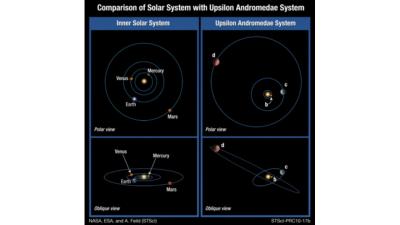
From above, all planetary orbits appear circular, while from the side, they all are in a flat line. The Upsilon Andromedae system (right) is an example of a rare, non-flat exoplanet system. [Images taken from NASA. 23 ]
In our solar system, the orbits of all of the planets and their moons are roughly flat, with relatively little deviation. 24 The Earth’s orbit around the Sun follows a very nearly circular path called the ecliptic. Indeed, seen from “above” the solar system looking down, the orbits of all of the planets follow nearly-circular orbits (Figure 2, top). The orbits of the other planets vary only a few degrees from the ecliptic, and so from a “side” view, they appear to all lie in a line (Figure 2, bottom left). Both our Moon and the regular moons 25 of the gas giants also lie roughly in the ecliptic.
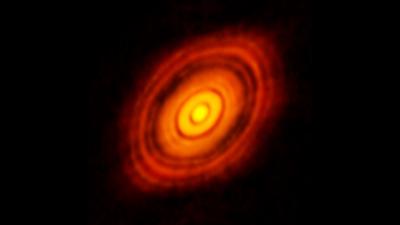
At the center of the image is HL Tauri, a star in formation. Around it is a hot disk of debris which is forming planets; planets in formation are carving out the gaps in the disk. [Image from the ALMA Partnership et al. (2016). 26 ]
Exoplanetary systems are also flat, like ours. This flatness is a prediction of the nebular hypothesis of solar system formation. 27 Solar systems should be flat, regardless of whether they have one, two, or more stars, and the number and size of planets and moons. Both solar systems in formation (Figure 3) and fully formed systems are observed to be flat as well, 28 although some exceptions exist (like Upsilon Andromedae; see Figure 2, right).
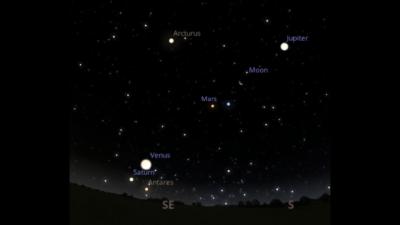
[Image created with the Stellarium Web applet 29 ]
The consequences of a flat solar system are simple: whenever standing on a planet or moon, everything within the solar system should lie roughly in a line across the sky (see Figure 4 for an example). 30 This happens because an observer on the surface of a planet is inside the solar system’s flat plane and looking through it.

When visualized from off-world, the system appears to fit the scientific model perfectly. It also properly models the structure of real systems with three stars.
Are the solar systems in fiction also flat? It depends. Seen from space, they appear to be flat, but from the ground are inconsistently flat.
Pitch Black provides its viewers with an orrery (see Figure 5), an explicit model of how its creators imagine the planet’s solar system works. The orrery shows a solar system which is flat: the planets all move in a flat plane. The unnamed planet is always lit because one star always lights half of the planet, and another pair lights the other half. In addition, the triple star system is a close binary in a wide binary with a third star, just like real triple star systems.
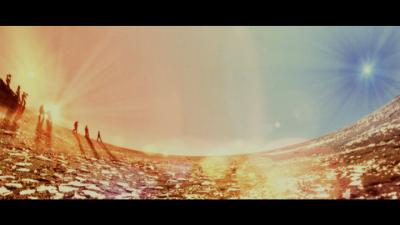
Even accounting for the wide-angle shot, there is no sensible way to draw a line through all three objects. Compare with Figure 4, for another wide-angle shot where all of the objects on the sky align. However, when the creators of Pitch Black show the audience what the sky looks like from the ground, this flatness disappears. When the protagonists are preparing for the impending eclipse, the viewers are shown several wide-angled shots showing the sky (Figure 6). The three stars, despite being in a plane, are not in a line, even when accounting for the lens distortion.
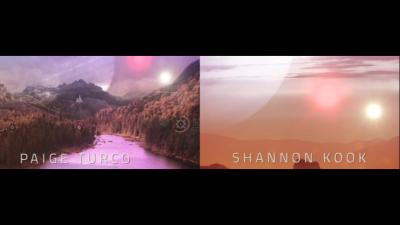
The 100’s sixth season lacks the beautiful orrery of Pitch Black, and the images of Sanctum from orbit do not give much insight into the system as a whole. For this series, we must rely on shots of the sky from ground alone. The show’s pilot episode features two images of the gas giant and its two stars simultaneously (Figure 7). Somehow the system is both not flat (left), as the objects aren’t aligned on the sky, yet it is flat (right), because they are.
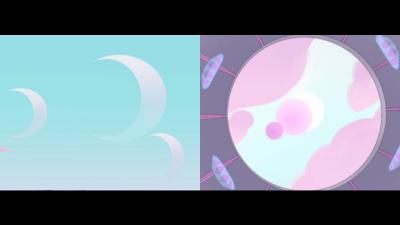
It is also unclear whether the Etheria system from She-Ra and the Princesses of Power is flat or not, since it is also observed solely from the ground in the series. One trio of moons are not aligned when they are mere hours from an eclipse (Figure 8, left) yet the moons suddenly all fall in a line at the moment of the eclipse (Figure 8, right).
Relative Independence of Orbits in the Solar System
Independence of orbits means that the orbits and rotations of objects in the solar system are not synchronized with each other. For example, it takes the Moon 27.32 days to orbit the Earth, 31 while the Earth takes 23 hours and 56 minutes to rotate on its axis once, and 365.26 days for the Earth to orbit the Sun once. 32 None of these time periods are equal or even simple multiples of each other. This lack of synchronization is quite troublesome for our calendar and clocks, requiring a complex leap year system. 33 The same sort of issue is present for other planets and their moons. In addition, each planet moves around the Sun at its own rate, with Earth moving faster than Mars; sometimes the two planets are close to each other and at other times far apart. Because gravity (presumably) works in the same way throughout the universe, this property should hold in all solar systems.
This does not, of course, mean that there are no laws governing orbits. Kepler’s 3rd Law 34 dictates the time it takes for a planet (or moon) to orbit the star (or planet) it orbits, and how quickly the object moves. 35 No such law exists for how long it takes for an object to rotate on its axis. The two times are almost completely independent.
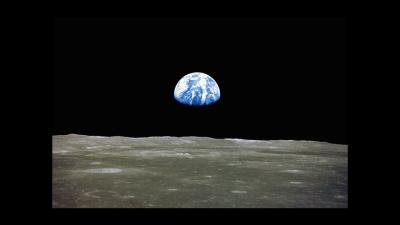
Because of tidal locking, when standing at this location, the Earth will never appear to rise, set, or move at all in the sky. The Earth will change phase though, depending on where the Moon is in its orbit around the sky. [Photograph from NASA. 36 ]
There is one notable exception to independence that should be briefly mentioned: the phenomenon of tidal locking. Over very long time periods a planet (or moon) will become tidally locked with what it is orbiting. 37 This occurs most commonly in moons; Earth’s Moon is tidally locked, which is why the face of the Moon always looks the same from the ground. Similarly, Earth never appears to rise or set while standing on the Moon (Figure 9); Earth is always in the same spot in the Moon’s sky at all times of day and night. In some cases, a planet can also become tidally locked with its moon. Pluto and its largest moon Charon always face each other.
Overall, independence means that while there are predictable rules for when planets, moons, and stars rise and set above the horizon, any two objects with different orbits can appear almost anywhere on the sky and at most times of day or night (except for the system’s stars which are never up at night, by definition). The following are features of a sky where objects move independently:
- A planet’s moons can be visible in the sky at any time of day or night, and will not in general be close together in the sky to each other.
- In a close binary, the two stars are close to each other physically and so will always appear close together in the sky; they will rise and set together.
- In a wide binary, the stars will be sometimes close together and sometimes far apart in the sky, depending on the time of year. They may not rise and set together, but their angle on the sky will change, as the planet orbits its primary star. 38
It is in synchronized orbits where we shall see the most frequent scientific errors in science fiction media. This is almost certainly because having multiple objects in the sky in a single shot is an extremely powerful setting technique; it very clearly says to the viewer that this scene is not Earth. There are thus strong narrative reasons to not stick to scientific accuracy.
Looking at Pitch Black, we again see that the orrery is scientifically accurate, but the view from the ground is not. The orrery shows a model where all of the planets and stars move independently. But, the ground shot of the stars (Figure 6) shows all three stars in the sky simultaneously. In most systems all three stars will sometimes, but not always all be visible. But, as we will see, in fiction it is all but guaranteed that all stars will always be visible during the day and all moons will always be visible every night. Interestingly, we also see a tension between the desire to set the scene (with all three stars visible) within the narrative of the film (it is always daytime all over the planet) because all three stars are visible here, it must be nighttime on the other side.
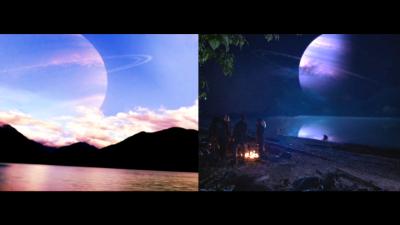
The motion of the objects in the sky of The 100 are synchronized in order to make the setting clear. This scene clarity is especially important here, because, as noted before, the first 5 seasons of The 100 were all set on Earth, while the 6th has moved to the moon Sanctum in another solar system. Figure 10 (left) shows a scene during the daytime shortly after the main characters arrive on Sanctum. The ringed planet that Sanctum orbits is visible in the sky, with the right half lit by the system’s two stars. In that shot, the stars are off-screen to the right, as a pan reveals. That evening, the suns have set, but the ringed planet remains exactly where it was in the sky during the day (Figure 10, right). Moreover, the left, rather than right half of the planet is now lit. This means we can infer that the stars are to the left of the planet (as they should be from the rotation of Sanctum on its axis, like Earth) but the planet has remained fixed—which it should not. 39 This motionless planet clearly shows how the artist who designed the sky imagines the solar system working: objects move across the sky, rather than planets and moons moving around stars, a geocentric model.

In She-Ra and the Princesses of Power, one of the most prominent features of Etheria is that it has a lot of moons: at least twelve. Viewers are shown how the moons orbit Etheria both from the ground and from space. Almost all of the moons are always visible in a narrow region of the sky above Brightmoon, the city which serves as the capital of the Alliance (Figure 11, left). This suggests that the orbits of the moons are synchronized. However, when seen from space, the moons are spread out around the planet, as they should be if they orbit the planet at different speeds (Figure 11, right).
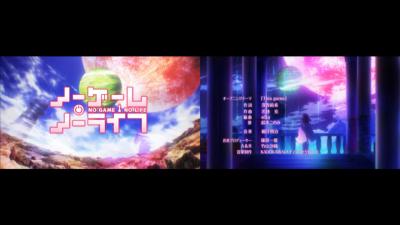
The world of Disboard from No Game No Life has two moons, as shown in Figure 12. Even though the world of Disboard, with its magic and fantasy races, is clearly not Earth, the two moons as shorthand for setting are ubiquitous. The two moons are shown together in the sky at every available opportunity, including when Sora and Shiro first arrive, as well as eight times during the opening credits of each episode (two are shown in the figure). The moons are also shown together in the film No Game No Life: Zero (2017) during an establishing shot right after the story begins. The moons in every example are shown close to each other on the sky, violating the assumption that orbits of the moons should be independent.
No Game No Life’s pervasive double moons are a particularly striking example, but prominent multi-moon systems can be observed in the sky of other isekai shows across subgenres. These include the fantasy series Familiar of Zero (2006), the digital world of Sword Art Online (2012) and the underworld of the isekai-ish Welcome to Demon School, Iruma-Kun! (2019).
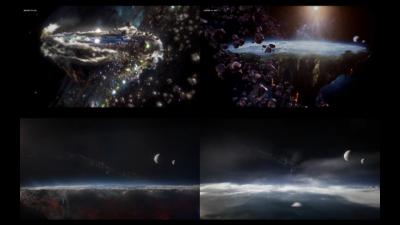
As the series progresses from Season 2 (top left) to Season 2 (top right), to Season 3 (bottom left), to season 4 (bottom right) the disk-world shape of Fillory becomes less prominent, and the two moons—initially absent—become the central focus.
Like so many of the other examples discussed above, the planet of Fillory from The Magicians has two moons whose orbits are synchronized and always appear together. This can be seen in the many establishing shots of Fillory. To make it clear that a scene is set in Fillory, viewers were initially shown a scene of flat Fillory without its moons (Figure 13, top left). By the end of season two and throughout seasons three and four, the moons slowly take on more prominence (top right and bottom left), and eventually the flatness of Fillory becomes irrelevant (bottom right). However, even though the moons have orbits synchronized to each other, the Moons are visible during the daytime, so there is no star during day and moons at night synchronization (Figure 13, top right).
It is also notable that the creators began to use the two moons to distinctly represent Fillory, because being flat would seem to be much more distinctive than just having two moons. Moreover, the moons are irrelevant to the overall plot of the show while the flatness of Fillory does matter. Two important locations have included the eternal waterfall at the edge of the world and Blackspire, a castle on the underside of Fillory.
The Brightness of the Sun
Starting with the uncontroversial, the Sun is the primary source of light in the solar system. Everything visible in the solar system is that way because the Sun’s light is reflecting off of it. The changing of the phases of the Moon is caused by how much light reflected off of the Moon can be seen by observers on Earth. However, exactly how the Sun’s lighting results in the phases of the Moon is poorly understood by the public. Many articles have been written on the topic of reforming mental models on the subject of the phases of the Moon. 40 In the interest of not repeating their work, I will summarize what is important for discussion.
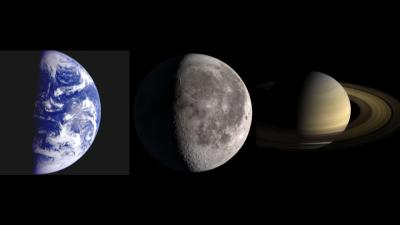
In each image, the Sun is implied to be to the right of the image, as the lit half of the object will be facing the Sun. [All images from NASA. 41 ]
Figure 14 shows the Earth, Moon, and Saturn all partially lit. Because the right half of each object is bright, the unshown Sun must be off to the right of each image. If we imagine that we were standing on a planet with two moons, and those moons are close on the sky, then they should have the same phase. Why? Because the Sun will be in the same location (left, right, above, etc.) relative to each one. If the two moons are currently on opposite parts of the sky, then the Sun may be striking them at different angles, and they can be in different phases. This holds on Earth, other planets in our solar system, and theoretically for any other planetary system with a single star. Wide binary star systems may have unusual phases not seen in the our solar system, because each object can be illuminated from two different angles.
Examples in the media showing moons and also a star in the sky are quite rare. So, examples where it is even possible to determine whether moon phases are correct or not are also rare. The orrery model in Pitch Black uses actual light bulbs to provide illumination, and so that model will by definition be correct. But the other examples in this section are much more complex; not only are such examples rare and unclear, but both series’ moons have magical or otherwise intentionally mysterious qualities to them.

When examining She-Ra’s solar system, we run into that science fiction versus fantasy question. It is difficult to assess how lighting works in the Etheria system. According to She-Ra’s creator, showrunner, and producer Noelle Stevenson, Etheria does not orbit a star and the moons generate their own light. 42 So, even though the phases of Eternia’s moons appear to be random, violating the lighting principle (Figure 15), sometimes multiple moons close on the sky do have the same phase (Figure 8, left).

Likewise, as a series full of magic, especially whimsical magic, it can be argued that much of the solar system dynamics in The Magicians is not even intended to have any appearance of plausibility. The Neitherlands, a series of ring-shaped planets, certainly aren’t. The moons of Fillory do not always have the same phase, even though they must, as they are always close together. This difference in phase is used to show how wondrous and magical Fillory is during one intro sequence, with the phases of the two moons rapidly changing (Figure 16, left), and there is another scene where the phases are exactly opposite (Figure 16, right). But, when seen from space (Figure 13, top right), the bright parts of the moon do point toward Fillory’s star. So we have yet another example where there is an inconsistency from the ground, but, seen from another viewpoint, the solar system appears to be scientifically correct.
Misconceptions and the Simple Geocentric Model
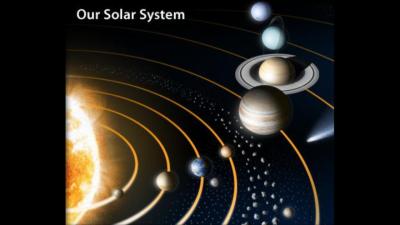
The features of solar systems described above: flatness, independence of orbits, and brightness of stars are well established by experiment. The public at large is aware of these features as well, even if not consciously so. For example, images of the solar system are consistently flat both when produced by NASA (see Figure 17) and media produced by non-experts. 43 It is also common knowledge that the Sun rises and sets once each day and that the Moon moves around the Earth roughly every month, two very different time scales. And, while it is frequently misunderstood how phases work, everyone knows that the Earth and Moon are bright because the Sun shines on them.
But these facts being common knowledge doesn’t mean that their consequences are clear. As an example, consider the common misconception that the Moon cannot be seen during the day. As noted above, it is common knowledge that the Earth’s rotational period (roughly 1 day) and the Moon’s orbital period (roughly 1 month) are very different. And anyone can confirm for themselves by looking up in the sky from time to time that the Moon can be—and often is—visible during the day. Yet a significant amount of effort has been spent on educating the public that this is even possible: NASA, 44 Space.com, 45 and Universe Today 46 (among many other astronomy websites for the public) all maintain pages on the topic. 47
How does this happen? Constructivist learning theory argues that the understanding of science (or any knowledge) is not a series of disconnected facts, but is a set of mental models which can be used to explain observations and make predictions. 48 As humans learn, we do not simply absorb information, but must actively build, change, or discard our existing mental models. This process begins with so-called naive models developed from everyday experience—for example, that the Earth is flat and that the Moon and Sun orbit it—and hopefully ends in a scientific understanding of the universe. 49
But between those two endpoints, children (and adults) may have conceptual models which are synthetic, combining naive ideas and attempting to reconcile them with what they are taught into a new, still incorrect model. In one model of particular interest, children may claim that there are two Earths: a flat, disk-shaped Earth on which people live, and a second, spherical Earth which is a planet “up in space” like all of the other planets. 50 This description comes from the tension between their everyday experience that the Earth is flat and objects fall down, that they are taught that the Earth is spherical, and seeing pictures of the solar system. Understanding how these two ideas are related requires a significant ability to visualize and think spatially, which must be actively developed over time. 51
This work appears to be incomplete, even among adults. Many college-age students 52 and teachers 53 carry with them both a scientific and a simplistic geocentric mental model of the solar system, which they rely on to solve different astronomy-related tasks.
I argue that we can use the previously discussed depictions of solar systems in science fiction and fantasy media to see these mixed models in the minds of the writers and artists who have produced them. In particular, the two different models are produced when this complex spatial reasoning is required: images of Earth and the solar system from space appeared scientific, while a shift into how that will be seen on the ground typically had errors indicative of a simplistic geocentric portrayal. 54 The specific evidence for this “geocentric” mental model was seen in the following properties, which are the exact opposite of the properties discussed in the previous sections:
Planets move across the sky on their orbits around the Earth. These orbits are not flat. Planets and moons may appear anywhere in the sky and do not need to roughly line up. More than half of the ground images discussed were not flat, while the images from space generally were.
There is a daily schedule of how objects move: moons will always be visible at night and only at night. If there are multiple stars, they will rise and set together, even in a wide binary. The orbits are highly synchronized. Every work discussed showed synchronized motions of moons or stars from the ground. Where such data were available, there was a lack of synchronization from space.
It’s not clear what causes phases. The bright halves of moons do not need to point toward a star, and when there are multiple moons close together, they can have different phases. We can say that in this model that moons and planets have their own intrinsic lighting. Both of the media texts with lunar phases discussed above showed a complicated relationship with moon phases from the ground, but even the eccentric moons of Fillory were properly lit when seen from space.
Conclusion
Alternative solar systems with multiple stars or moons are used commonly in fiction, from Star Wars and its many sequels to television series like She-Ra and The 100. They serve as a clear way to set the scene apart from our everyday experiences on Earth. Even in a fantasy series like The Magicians, where there are fantastic, unusually-shaped planets, the image of moons like our own—but two of them—has eventually become the most prominent signifier that a scene isn’t set on Earth.
These images are both striking and realistic; the real world contains plenty of known binary and triple star systems, and it’s not necessary to leave our solar system to find planets with dozens of moons. But the solar systems in science fiction and fantasy media aren’t scientifically accurate in other, subtler ways. By looking at how and when the solar systems are depicted, we can see inside the minds of the creators and find a consistency to the inaccuracies. Depictions from space (or models of the solar system) are typically correct: we see flat solar systems, with relatively independent orbits, and correct moon and planet phases. But from the ground looking at the sky, these features are generally absent.
This may suggest that the creators are having difficulty switching between the perspective from space (a heliocentric reference frame) and from the ground (a geocentric one). These kinds of misconceptions are well-studied and widely observed in both children and adults. Most people carry with them a combination of a scientific and a simplistic geocentric mental model of the solar system.
Bibliography
Adams, Fred C. “The Birth Environment of the Solar System.” Annual Review of Astronomy and Astrophysics, vol. 48 (2010): 47-85.
ALMA Partnership et al. “The 2014 ALMA Long Baseline Campaign: First Results from High Angular Resolution Observations toward the HL Tau Region.” Astrophysical Journal Letters, vol. 808, no. 1 (2015): L3. (https://iopscience.iop.org/article/10.1088/2041-8205/808/1/L3/pdf)
Bixler, Andrea. “Teaching Evolution with the Aid of Science Fiction.” The American Biology Teacher, Vol. 69 (2007): 337-340. (https://www.researchgate.net/publication/232667258_Teaching_Evolution_with_the_Aid_of_Science_Fiction)
Calderón-Canales, Elena, Flores-Comacho, Fernando, and Gallegos-Cázares, Leticia. “Elementary Students’ Mental Models of the Solar System.” Astronomy Education Review, vol. 12, no. 1 (2013): 17 pages.
Charles Q. Choi. “Real-Life ‘Tatooine’: New ‘Star Wars’-Like Planet with 2 Suns Found.” Space.com, January 11, 2012. (https://www.space.com/14203-alien-planets-2-suns-tatooine-star-wars-aas219.html)
Cole, Merryn, Cohen, Cheryl, Wilhelm, Jennifer, and Lindell, Rebecca. “Spatial thinking in astronomy education research.” Physical Review Physics Education Research, vol. 14 (2018): 27 pages. (https://journals.aps.org/prper/abstract/10.1103/PhysRevPhysEducRes.14.010139)
Fang, Julia and Margot, Jean-Luc. “Architecture of Planetary Systems Based on Kepler Data: Number of Planets and Coplanarity.” Astrophysical Journal, vol. 761, no. 2 (2012): 14 pages. (https://iopscience.iop.org/article/10.1088/0004-637X/761/2/92/pdf)
Fara, Patricia. “Science & Shelley: What Mary Knew.” History Today, May 5, 2010. (https://www.historytoday.com/archive/science-shelley-what-mary-knew)
Flynn, Simon and Hardman, Mark. “The Use of Interactive Fiction to Promote Conceptual Change in Science. A Forceful Adventure.” Science & Education, vol. 28, no. 1-2 (2019): 127-152. (https://link.springer.com/article/10.1007/s11191-019-00032-6)
Fraknoi, Andrew. “Teaching Astronomy with Science Fiction: A Resource Guide.” Astronomy Education Review, vol. 1, no. 2 (2002): 112-119
Gillon, Michael, et al. “Seven temperate terrestrial planets around the nearby ultracool dwarf star TRAPPIST-1.”Nature, vol. 542, no. 7642 (2017): 456-460.
Howard, Andrew W. “Observed Properties of Exoplanets.” Science, vol. 340, no. 6132 (2013): 572-576.
Jordan, Philipp, Mubin, Omar, Obaid, Mohammed, and Silva, Paula Alexandra. “Exploring the Referral and Usage of Science Fiction in HCI Literature,” in User Experience, and Usability: Designing Interactions. DUXU 2018. Lecture Notes in Computer Science Volume 10909, Marcus A., and Wang W., eds. Cham, Switzerland: Springer, 2018: 19-38. (https://link.springer.com/chapter/10.1007%2F978-3-319-91803-7_2)
Larsen, Kristine. “Teaching Astronomy Really Dynamically Involving Sci-Fi, or the Other TARDIS.” Ensuring Stem Literacy: A National Conference on STEM Education and Public Outreach. ASP Conference Series, vol. 483 (2014): 115.
Lewis, John, Physics and Chemistry of the Solar System. San Diego: Academic Press, 2002.
Pundak, David, Liberman, Ido, and Shacham, Miri. “From Conceptual Frameworks To Mental Models For Astronomy: Students’ Perceptions.” Journal of Astronomy & Earth Sciences Education, vol. 4, no. 2 (2017): 109-126. (https://files.eric.ed.gov/fulltext/EJ1170365.pdf)
Shen, Ji and Confrey, Jere. “Justifying Alternative Models in Learning Astronomy: A study of K-8 science teachers’ understanding of frames of reference.” International Journal of Science Education, vol. 32, no. 1 (2010): 1-29
Thornton, Stephen T. and Marion, Jerry B. Classical Dynamics. Belmont: Brooks/Cole, 2004.
Vosniadou, Stella “Capturing and Modeling the Process of Conceptual Change.” Learning and Instruction, vol. 4 (1994): 45-69. (http://citeseerx.ist.psu.edu/viewdoc/download?doi=10.1.1.541.5078&rep=rep1&type=pdf)
Footnotes
- Charles Q. Choi. “Real-Life ‘Tatooine’: New ‘Star Wars’-Like Planet with 2 Suns Found.” Space.com, January 11, 2012, (https://www.space.com/14203-alien-planets-2-suns-tatooine-star-wars-aas219.html)
- See, for example, Neel V. Patel. “Astronomers Find a Tatooine-Like, Two-Star System,” Inverse.com, February 27, 2017, (https://www.inverse.com/article/28392-real-life-tatooine-like-star-system) ; Fraser Cain. “Can Tatooine Be Real?” Universe Today, April 10, 2014, (https://www.universetoday.com/111039/can-tatooine-be-real/) ; Eric Mack. “Real-life Star Wars Tatooine could be a beachy destination,” CNET, April 12, 2017 (https://www.cnet.com/news/star-wars-tatooine-could-exist-in-real-life/)
- Trent Perrotto and Michele Johnson. “NASA To Announce Kepler Discovery at Media Briefing,” NASA, September 13, 2011, (https://www.nasa.gov/home/hqnews/2011/sep/HQ_M11-192_Kepler_Briefing.html)
- “Where your shadow always has company,” NASA, accessed January 3, 2020, (https://exoplanets.nasa.gov/resources/2082/where-your-shadow-always-has-company/)
- Patricia Fara. “Science & Shelley: What Mary Knew,” History Today, May 5, 2010, (https://www.historytoday.com/archive/science-shelley-what-mary-knew)
- Mark Strauss. “Ten Inventions Inspired by Science Fiction,” Smithsonian Magazine, March 15, 2012, (https://www.smithsonianmag.com/science-nature/ten-inventions-inspired-by-science-fiction-128080674/)
- Philipp Jordan, Omar Mubin, Mohammed Obaid, and Paula Alexandra Silva, “Exploring the Referral and Usage of Science Fiction in HCI Literature.” In User Experience, and Usability: Designing Interactions. DUXU 2018. Lecture Notes in Computer Science Volume 10909, ed. Marcus A., Wang W. (Cham, Switzerland: Springer, 2018), 19-38, (https://link.springer.com/chapter/10.1007%2F978-3-319-91803-7_2)
- Andrea Bixler. “Teaching Evolution with the Aid of Science Fiction.” The American Biology Teacher. vol. 69 (2007): 337-340, (https://www.researchgate.net/publication/232667258_Teaching_Evolution_with_the_Aid_of_Science_Fiction)
- Simon Flynn and Mark Hardman. “The Use of Interactive Fiction to Promote Conceptual Change in Science. A Forceful Adventure.” Science & Education. Vol. 28, Issue 1-2 (2019): 127-152, (https://link.springer.com/article/10.1007/s11191-019-00032-6)
- See Kristine Larsen. “Teaching Astronomy Really Dynamically Involving Sci-Fi, or the Other TARDIS,” Ensuring Stem Literacy: A National Conference on STEM Education and Public Outreach. ASP Conference Series, vol. 483 (2014): 115; Also see Andrew Fraknoi. “Teaching Astronomy with Science Fiction: A Resource Guide,” Astronomy Education Review, vol. 1, no. 2 (2002): 112-119.
- Google search results for search terms “Errors in Science Fiction Films.” Google, accessed December 29, 2019, (https://www.google.com/search?q=errors+in+science+fiction+films&rlz=1C1GCEA_enUS763US763&oq=errors+in+s&aqs=chrome.1.69i57j69i59j0l3j69i64l3.2022j0j7&sourceid=chrome&ie=UTF-8)
- Megan Gambino. “Top 5 ‘Science Done Wrong’ Moments in Movies,” Smithsonian Magazine, September 19, 2012, (https://www.smithsonianmag.com/science-nature/top-5-science-done-wrong-moments-in-movies-42179914/)
- Aaron Edwards. “The 15 Most Inaccurate Science Fiction Movies Of All Time,” Ranker, (https://www.ranker.com/list/science-fiction-movies-with-bad-science/aaron-edwards)
- Japanese for “another world”
- A similar English-language genre is portal fiction, which includes titles like The Lion, the Witch, and the Wardrobe.
- Often after being run over by a delivery truck, affectionately known as “Truck-kun” by fans.
- Earth has one (Luna), Mars has two small captured asteroids (Phobos and Deimos), and the others have none.
- “NASA Exoplanet Archive,” NASA/ipac, accessed January 1, 2020, (https://exoplanetarchive.ipac.caltech.edu/docs/counts_detail.html)
- Andrew W. Howard, “Observed Properties of Exoplanets,” Science, vol. 340, no. 6132 (2013): 572-576.
- Michael Gillon, et al. “Seven temperate terrestrial planets around the nearby ultracool dwarf star TRAPPIST-1,” Nature, vol. 542, no. 7642 (2017): 456-460.
- This drawing is an oversimplification of binary systems. In reality, the two stars will not be on opposite sides of the same orbit unless they have exactly the same mass. Instead, they will be on opposite sides of differently-sized roughly circular orbits which are concentric.
- “Figure-eight” configurations where a planet switches which star it orbits are unstable and have not been observed.
- Holly Zell, “Out of Whack Planetary System Offers Clues to a Disturbed Past,” NASA, Last Updated May 25, 2010, (https://www.nasa.gov/mission_pages/hubble/science/outofwack.html)
- Fred C. Adams, “The Birth Environment of the Solar System,” Annual Review of Astronomy and Astrophysics, vol. 48 (2010): 47-85.
- “Regular” moons are moons which formed along with the planet, and were not captured later. Because they formed the same way, their orbits share many of the same characteristics of their host planet, i.e. they lie roughly in the ecliptic.
- ALMA Partnership et al, “The 2014 ALMA Long Baseline Campaign: First Results from High Angular Resolution Observations toward the HL Tau Region,” Astrophysical Journal Letters, vol. 808, no. 1 (2015): L3, (https://iopscience.iop.org/article/10.1088/2041-8205/808/1/L3/pdf)
- Adams, “Birth,” Annual Review of Astronomy and Astrophysics, vol. 48 (2010): 47-85
- Julia Fang and Jean-Luc Margot, “Architecture of Planetary Systems Based on Kepler Data: Number of Planets and Coplanarity,” Astrophysical Journal, vol. 761, no. 2 (2012), (https://iopscience.iop.org/article/10.1088/0004-637X/761/2/92/pdf)
- “Stellarium Web Online Star Map,” Stellarium, accessed December 28, 2019, (https://stellarium-web.org/)
- Because of the small inclination of orbits relative to the ecliptic, they do not exactly line up, a fact which becomes clear when objects are very close to each other. The media examples shown later will clearly and egregiously violate this rule.
- Molly Wasser, “In Depth | About the Moon,” NASA, accessed December 29, 2019 (https://moon.nasa.gov/about/in-depth/)
- “Earth: Planet Profile,” NASA, Accessed December 30, 2019, (https://pds.jpl.nasa.gov/planets/special/earth.htm) . Additionally, there is a small but significant discrepancy between the 23 hours, 56 minutes of the Earth’s rotation and the 24 hour length of a day. The 23 hours, 56 minutes is the time it takes for the stars in the sky to return to the same spot on the sky (i.e. for an observer on the ground to point the same direction). The 24 hours is the time it takes for the Sun to appear in the same direction of the sky. These are not the same because as the Earth rotates, it moves around the Sun. This difference is why there are different constellations in the sky during different seasons, for example.
- The Gregorian calendar requires not only an extra day every 4 years, but leap years are skipped every 100 years (1900 was not a leap year, for example), but then they still occur every 400 years (2000 was a leap year).
- Kepler’s 3rd Law follows directly from Newton’s laws in a system with two bodies (e.g. a star and a planet), but requires advanced math to derive. It is a simplification that will hold to very high precision whenever there is a hierarchical structure to a solar system: only one very massive object (a star), some well-spaced medium-mass objects (planets) orbiting it, and low-massive objects (moons) orbiting those planets, and so on.
- Stephen T. Thornton and Jerry B. Marion, Classical Dynamics, (Belmont: Brooks/Cole, 2004), 303.
- Dave Williams and Jay Friedlander, “Earth - Apollo 11,” NASA, accessed January 2, 2020, (https://nssdc.gsfc.nasa.gov/imgcat/html/object_page/a11_h_44_6552.html)
- John Lewis, Physics and Chemistry of the Solar System. (San Diego: Academic Press, 2002), 242-243.
- Imagine looking up at the sky from the planet in Figure 1 (right). As that planet moves in its orbit, sometimes the two stars will be in the same direction, and sometimes in opposite directions.
- If the moon is tidally locked around its planet, then this scene could work, but then we would expect a day on Sanctum to be multiple Earth days in length, a fact which is never commented upon.
- See, for example, “Misconceptions | About the Moon,” NASA, accessed December 30, 2019, (https://moon.nasa.gov/about/misconceptions/) ; Ana V. Aceves, “What are the phases of the moon?” Sky & Telescope, July 6, 2019, (https://skyandtelescope.org/astronomy-resources/what-are-the-phases-of-the-moon/) ; Karen Masters, “How do I explain to my children why the moon has phases?” Curious? Ask an Astronomer, October 10, 2005, (http://curious.astro.cornell.edu/46-our-solar-system/the-moon/observing-the-moon/138-how-do-i-explain-to-my-children-why-the-moon-has-phases-beginner?highlight=WyJwaGFzZXMiXQ==)
- Galileo Team, “Earth - Departing Image by Galileo,” NASA/JPL, February 8, 1996, (https://www.jpl.nasa.gov/spaceimages/details.php?id=PIA00232) ; Ernie Wright, “Moon Phase and Libration, 2018,” NASA, December 18, 2017, (https://svs.gsfc.nasa.gov/cgi-bin/details.cgi?aid=4604&linkId=46432051) ; “Changing Seasons on Saturn,” NASA/JPL, accessed December 28, 2019, (https://rps.nasa.gov/resources/46/changing-seasons-on-saturn/)
- Yahoo Entertainment, “ ‘She-Ra and the Princesses of Power’ Season 2 cast Q&A,” video, (https://www.youtube.com/watch?v=dFteOs2I3FQ)
- In a Google image search for “solar system,” only one of the first 100 results showed a solar system which was not flat (entry 97, (https://www.snorgtees.com/solar-system)), and even this one was an artistic attempt to mash together many fictional solar systems, each of which were flat. Approximately two thirds of images explicitly showed lines of the planet orbits and made it clear that the solar system is flat (retrieved 12/31/2019).
- “Misconceptions | About the Moon,” NASA, accessed December 30, 2019, (https://moon.nasa.gov/about/misconceptions/)
- Geoff Gaherty, “Why Do We See the Moon in Daylight?” SPACE.com, September 10, 2009, (https://www.space.com/7267-moon-daylight.html)
- Ray Sanders, “How Can You See the Sun and the Moon at the Same Time?” Universe Today, September 19, 2011, (https://www.universetoday.com/88956/how-can-you-see-the-sun-and-the-moon-at-the-same-time/)
- The author has also been asked about this at outreach events from people who were astounded and unable to believe their eyes when they happened to see the Sun and Moon in the sky at the same time.
- Stella Vosniadou “Capturing and Modeling the Process of Conceptual Change,” Learning and Instruction, vol. 4 (1994): 45-69, (http://citeseerx.ist.psu.edu/viewdoc/download?doi=10.1.1.541.5078&rep=rep1&type=pdf)
- Elena Calderón-Canales, Fernando Flores-Comacho, and Leticia Gallegos-Cázares. “Elementary Students’ Mental Models of the Solar System.” Astronomy Education Review, vol. 12, no. 1 (2013): 17 pages.
- Vosniadou “Capturing” (http://citeseerx.ist.psu.edu/viewdoc/download?doi=10.1.1.541.5078&rep=rep1&type=pdf)
- Merryn Cole, Cheryl Cohen, Jennifer Wilhelm, and Rebecca Lindell, “Spatial thinking in astronomy education research,” Physical Review Physics Education Research, vol. 14 (2018): 27 pages, (https://journals.aps.org/prper/abstract/10.1103/PhysRevPhysEducRes.14.010139)
- David Pundak, Ido Liberman, and Miri Shacham. “From Conceptual Frameworks To Mental Models For Astronomy: Students’ Perceptions,” Journal of Astronomy & Earth Sciences Education, vol. 4, no. 2 (2017): 109-126.
- Ji Shen and Jere Confrey. “Justifying Alternative Models in Learning Astronomy: A study of K-8 science teachers’ understanding of frames of reference.” International Journal of Science Education, vol. 32, no. 1 (2010): 1-29.
- Do not confuse this with the highly complex geocentric model of Ptolemy’s Almagest which, while an incorrect model of the layout of the solar system, nevertheless produced extremely accurate predictions. The simple geocentric model produces many incorrect predictions.